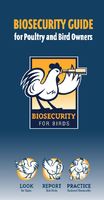Browse Items: 5
Poultry 2004 Part IV: Reference of Health and Management of Backyard / Small Production Flocks and Gamefowl Breeder Flocks in the United States
For Poultry ’04, NAHMS conducted a thorough assessment to determine the information needs of the poultry industry, researchers, and Federal and State governments. This assessment indicated a need for information regarding bird health, bird movement, and biosecurity practices of nontraditional poultry industries, such as backyard flocks, gamefowl,…
Small Enterprise Chicken Study, 2007
The Small Enterprise Chicken Study, 2007 is NAHMS’ third study of the poultry industry. The study provides national information on biosecurity practices and bird movement on operations with 1,000 to 19,999 chickens. The study was conducted in August 2007 and was based upon a statistically selected sample of 2,511 operations.
Poultry 2010: Urban Chicken Ownership in Los Angeles County, California 2010
Raising chickens in urban environments is a growing phenomenon in the United States. Urban chicken flocks are not part of the commercial poultry industry; however, they sometimes provide chicken meat and eggs to local food systems such as farmers’ markets. Urban chickens represent an avian population for which very little information is available.…
Urban Chicken Ownership in Four U.S. Cities
Raising chickens in urban environments is a growing phenomenon in the United States. Urban chicken flocks are not part of the commercial poultry industry; however, they sometimes provide chicken meat and eggs to local food systems such as farmers’ markets. Urban chickens represent an avian population for which very little information is available.…
Biosecurity Guide for Poultry and Bird Owners
This guide was designed to provide useful information on biosecurity for poultry and bird owners. The United States works very hard to prevent infectious poultry diseases such as highly pathogenic avian influenza and exotic Newcastle disease from being introduced into the country. To accomplish this, the U.S. Department of Agriculture (USDA)…
 An official website of the United States government.
An official website of the United States government.






